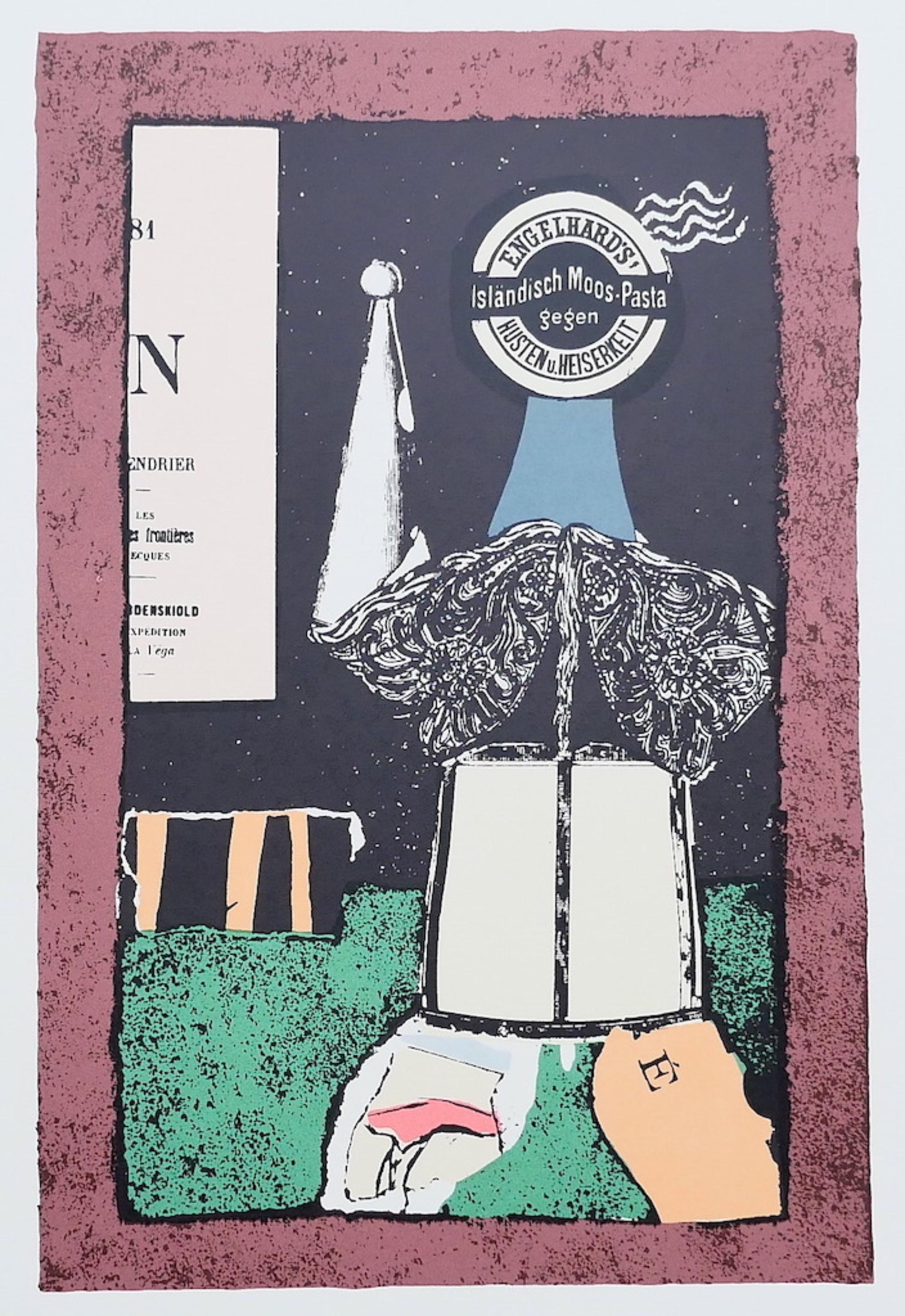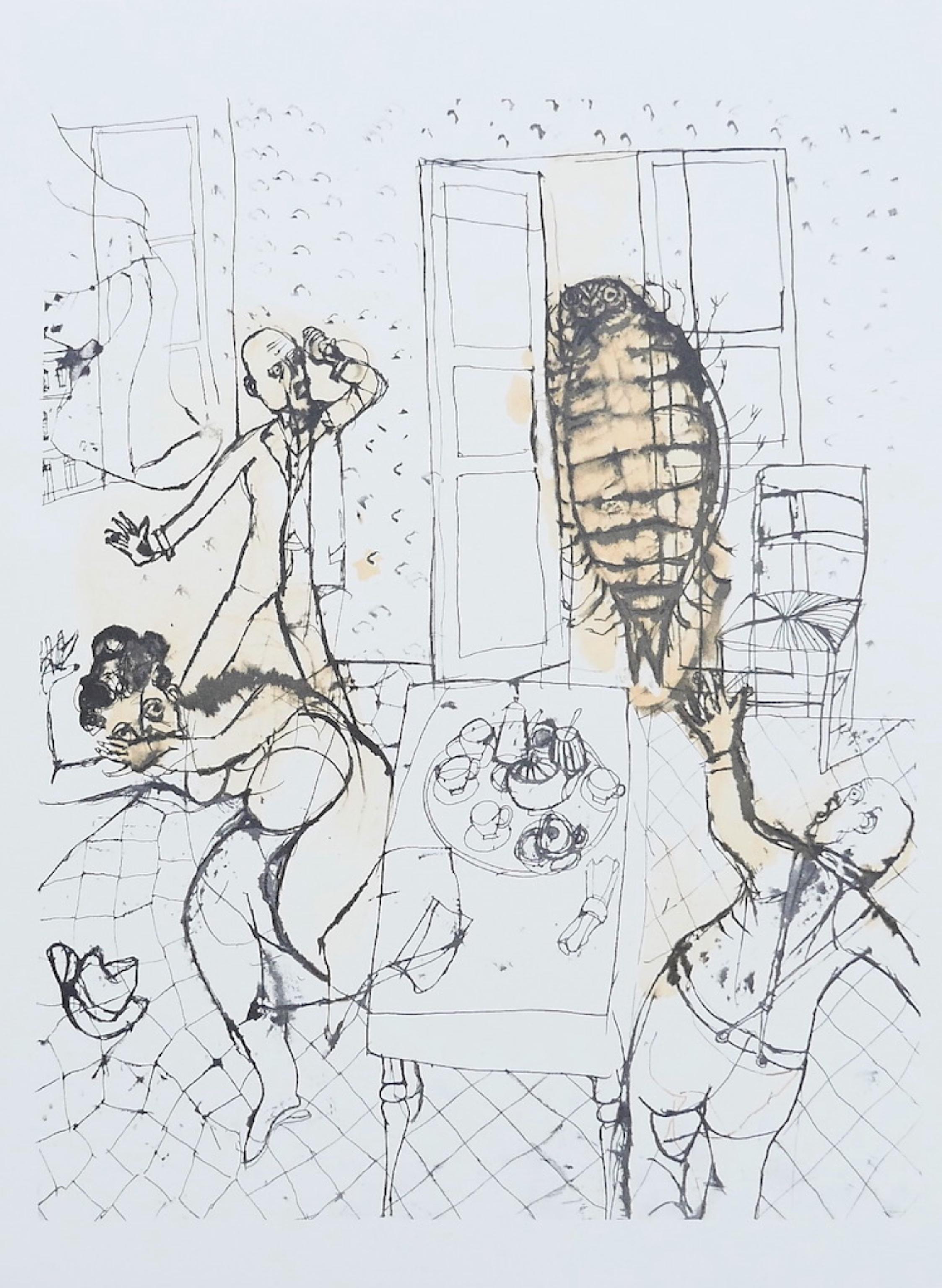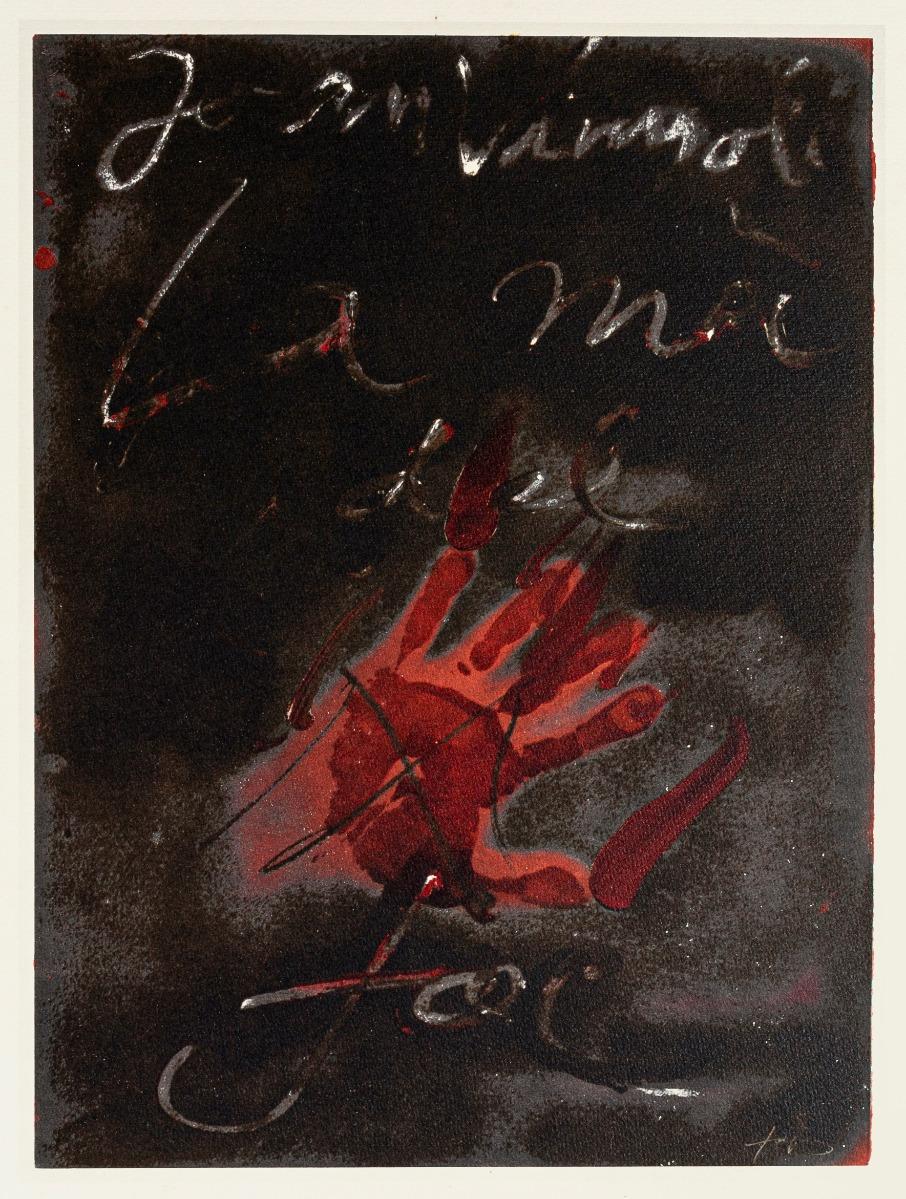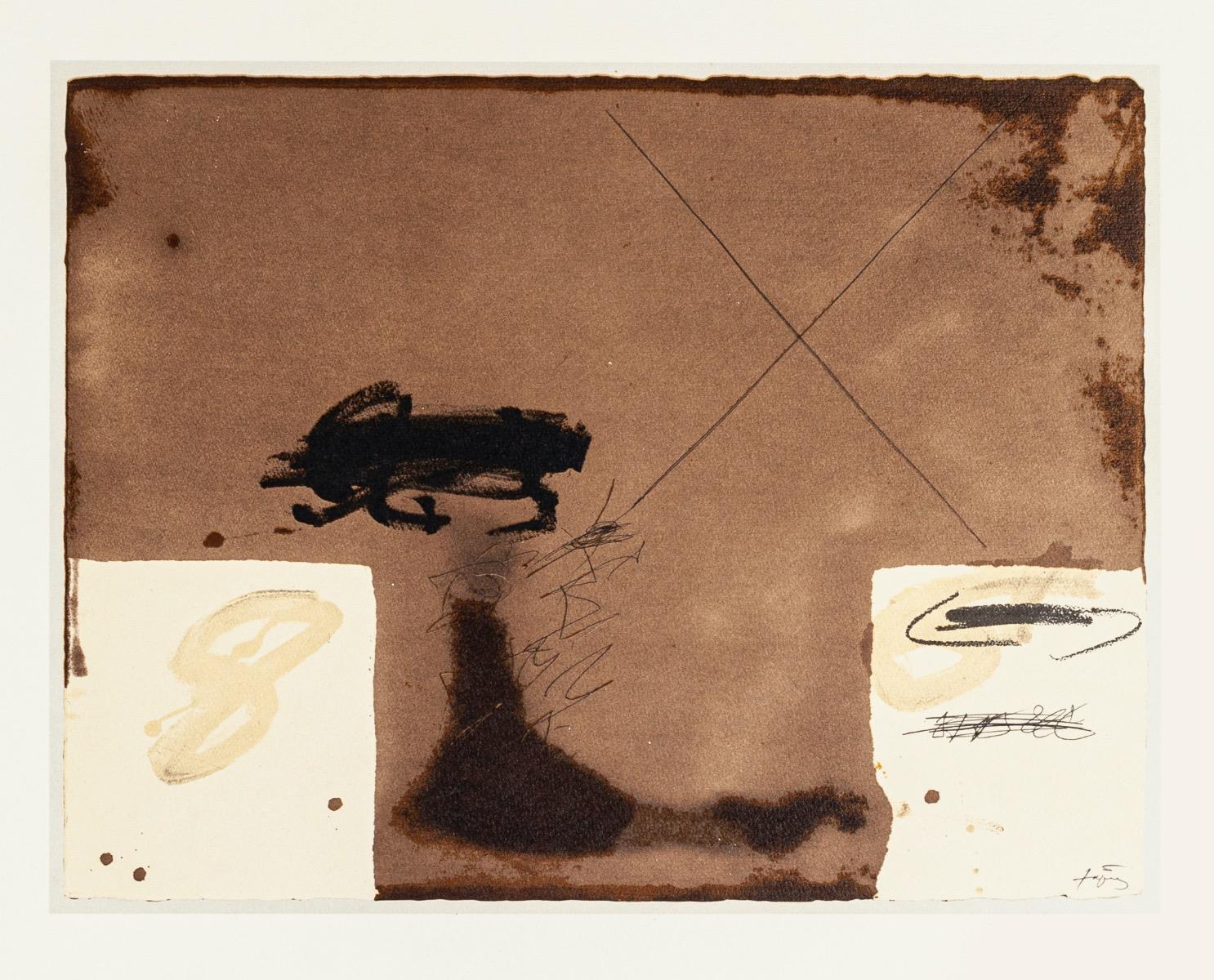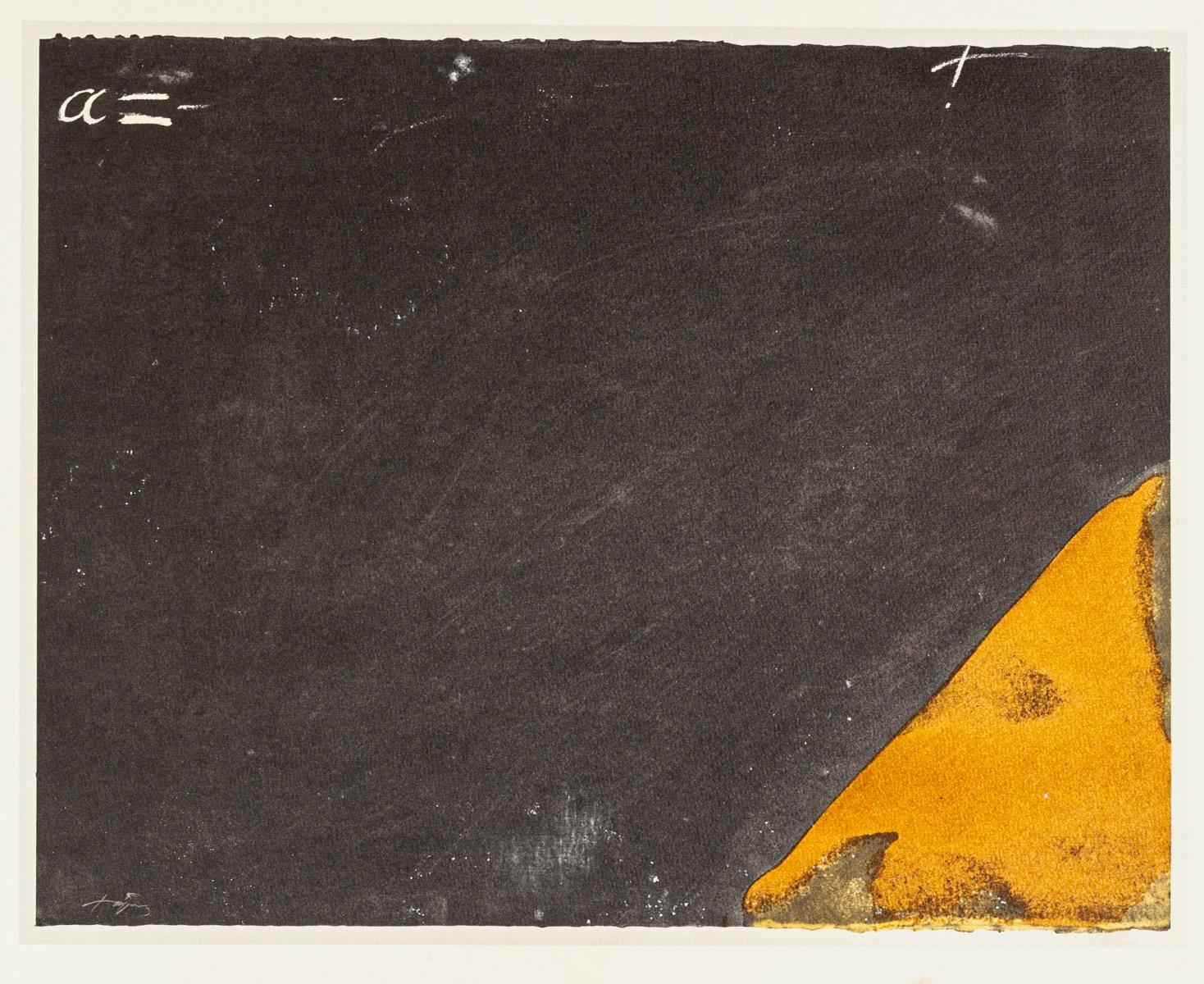Items Similar to Jambs - Vintage Offset Print after Antoni Tàpies - 1982
Want more images or videos?
Request additional images or videos from the seller
1 of 3
Antoni Tàpies (after)Jambs - Vintage Offset Print after Antoni Tàpies - 19821982
1982
About the Item
Jambs is a vintage offset print after Antoni Tàpies, printed on hand made paper.
The artwork is one of the deluxe edition of 1982 limited to 2.000 dedicated to Tapies' works. Signed on the plate. Titled on the rear and dated, plate no. 13.
Very good conditions.
The artwork represents a poetical composition through confident and strong strokes, with harmony in colors and shapes. The artwork is one of the typical graphic works realized by the artist. Over the course of his career in painting, printmaking, and etching, the Catalan artist has created his own artistic language characterized by symbols and marks from the politic and the social ground. His graphic production focuses on the same themes of this painting: love for his Catalan roots and loyalty to politics. In this artwork, noteworthy is the writing "Libertat", realized by the artist in the center of the composition above the Informal abstract shapes.
Antoni Tàpies (Barcelona, 1923 – 2012). One of the greatest Spanish artists of the XX century, he is considered one of the leading figures of Informalism. After establishing his first atelier in Barcelona in 1946, he moved to Paris, where he met Picasso. In 1950, he was elected to represent Spain at the Biennial Art Fair in Venice. From this moment, Tàpies' career kept developing in influence and volume of work. Indeed, he was commissioned many works for public spaces and buildings. Tàpies was also an innovator in many fields, such as scenography and illustration. He exhibited his works throughout the world, winning many honors and awards. In 1987, the artist founded the Fundació Antoni Tàpies in Barcelona.
- Creator:Antoni Tàpies (after)
- Creation Year:1982
- Dimensions:Height: 8.27 in (21 cm)Width: 11.42 in (29 cm)Depth: 0.04 in (1 mm)
- Medium:
- Movement & Style:
- Period:
- Framing:Framing Options Available
- Condition:Insurance may be requested by customers as additional service, contact us for more information.
- Gallery Location:Roma, IT
- Reference Number:
About the Seller
4.9
Platinum Seller
These expertly vetted sellers are 1stDibs' most experienced sellers and are rated highest by our customers.
1stDibs seller since 2017
6,770 sales on 1stDibs
Typical response time: 3 hours
- ShippingRetrieving quote...Ships From: Grasse, France
- Return PolicyA return for this item may be initiated within 14 days of delivery.
More From This SellerView All
- Pointing - Vintage Offset by Franco Gentilini - 1970sBy Franco GentiliniLocated in Roma, ITPointing is an original Vintage Offset Print on ivory-colored paper, realized by Franco Gentilini (Italian Painter, 1909-1981), in Late 20th Century. The state of preservation of th...Category
1970s Modern Abstract Prints
MaterialsOffset
- Figure - Original Offset by Franco Gentilini - 1970sBy Franco GentiliniLocated in Roma, ITFigure is an original Vintage Offset Print on ivory-colored paper, realized by Franco Gentilini (Italian Painter, 1909-1981), in 1970s. The state of preservation of the artwork is e...Category
1970s Modern Abstract Prints
MaterialsOffset
- Metamorphosis - Vintage Offset by Franco Gentilini - 1970sBy Franco GentiliniLocated in Roma, ITMetamorphosis is original photolithography offset on ivory-colored paper, realized by Franco Gentilini (Italian Painter, 1909-1981), in the 1970s. The state of preservation of the a...Category
1970s Modern Abstract Prints
MaterialsOffset
- Hand of Fire - Vintage Offset Print After Antoni Tàpies - 1982Located in Roma, ITHand of Fire is a vintage offset print after Antoni Tàpies, printed on hand made paper. It is one of the prints belonging to a deluxe edition of 1982 limited to 2.000 specimens, repr...Category
1980s Modern Abstract Prints
MaterialsOffset
- Two White Rectangles - Vintage Offset Print after Antoni Tàpies - 1982Located in Roma, ITTwo White Rectangles is original vintage offset print artwork after Antoni Tàpies, printed on hand made paper. The artwork is one of the deluxe edition of 1982 limited to 2.000 dedi...Category
1980s Modern Abstract Prints
MaterialsOffset
- Angle - Vintage Offset Print After Antoni Tàpies - 1982Located in Roma, ITAngle is a vintage offset print after Antoni Tàpies, printed on hand made paper. It is one of the prints belonging to a deluxe edition of 1982 limited to 2.000 specimens, reproducing...Category
1980s Modern Abstract Prints
MaterialsOffset
You May Also Like
- Large Johnny Friedlaender Poster Print No TextBy Johnny FriedlaenderLocated in Surfside, FLJohnny Friedlaender (26 December 1912 – 18 June 1992) was a leading 20th-century artist, whose works have been exhibited in Germany, France, Netherlands, Italy, Japan and the United States. He has been influential upon other notable artists, who were students in his Paris gallery. His preferred medium of aquatint etching is a technically difficult artistic process, of which Friedlaender has been a pioneer. Gotthard Johnny Friedlaender was born in Pless (Pszczyna), Prussian Silesia, as the son of a pharmacist. He was graduated from the Breslau (Wrocław) high school in 1922 and then attended the Academy of Arts (Akademie der Bildenden Kunste) in Breslau, where he studied under Otto Mueller. He graduated from the Academy as a master student in 1928. In 1930 he moved to Dresden where he held exhibitions at the J. Sandel Gallery and at the Dresden Art Museum. He was in Berlin for part of 1933, and then journeyed to Paris. After two years in a Nazi concentration camp, he emigrated to Czechoslovakia, where he settled in Ostrava, where he held the first one-man show of his etchings. In 1936 Friedlaender journeyed to Czechoslovakia, Switzerland, Austria, France and Belgium. At the Hague he held a successful exhibition of etchings and watercolours. He fled to Paris in 1937 as a political refugee of the Nazi regime with his young wife, who was an actress. In that year he held an exhibition of his etchings which included the works: L ‘Equipe and Matieres et Formes. From 1939 to 1943 he was interned in a series of concentration camps, but survived against poor odds. After freedom in 1944 Friedlaender began a series of twelve etchings entitled Images du Malheur with Sagile as his publisher. In the same year he received a commission to illustrate four books by Freres Tharaud of the French Academy. In 1945 he performed work for several newspapers including Cavalcade and Carrefour. In the year 1947 he produced the work Reves Cosmiques and in that same year he became a member of the Salon de Mai, which position he held until 1969. In the year 1948 he began a friendship with the painter Nicolas de Staël and held his first exhibition in Copenhagen at Galerie Birch. The following year he showed for the first time in Galerie La Hune in Paris. After living in Paris for 13 years, Friedlaender became a French citizen in 1950. Friedlaender expanded his geographic scope in 1951 and exhibited in Tokyo in a modern art show. In the same year he was a participant in the XI Trienale in Milan, Italy. By 1953 he had produced works for a one-man show at the Museum of Neuchâtel and exhibited at the Galerie Moers in Amsterdam, the II Camino Gallery in Rome, in São Paulo, Brazil and in Paris. He was a participant of the French Italian Art Conference in Turin, Italy that same year. Friedlaender accepted an international art award in 1957, becoming the recipient of the Biennial Kakamura Prize in Tokyo. In 1959 he received a teaching post awarded by UNESCO at the Museum of Modern Art in Rio de Janeiro. By 1968 Friedlaender was travelling to Puerto Rico, New York City and Washington, D.C. to hold exhibitions. That year he also purchased a home in the Burgundy region of France. 1971 was another year of diverse international travel including shows in Bern, Milan, Paris, Krefeld and again New York. In the latter city he exhibited paintings at the Far Gallery, a venue becoming well known for its patronage of important twentieth-century artists. From his atelier in Paris Friedlaender instructed younger artists who themselves went on to become noteworthy, among them Arthur Luiz Piza, Brigitte Coudrain...Category
Mid-20th Century Modern Abstract Prints
MaterialsOffset, Screen
- French Modernist Mourlot Lithograph Vintage Air France Poster Roger BezombesBy Roger BezombesLocated in Surfside, FLVintage French Travel Poster, Air France Roger Bezombes (1913-1994) French Bezombes was a painter, sculptor, medalist, and designer. He studied in Paris, at the École des Beaux-Arts, and was much influenced by his friendship with Maurice Denis. Heavily influenced by surrealism, He worked principally as a painter, adopting the saturated Fauvist colors of Henri Matisse in landscapes and figure studies often based on observation of “exotic” cultures, notably Mediterranean and North African. Constrained, because a very young orphan, to all kinds of professions which provide him with the material means to devote himself to painting - he participated in 1930 in the installation of the exhibition of the Bauhaus at the Grand Palais-, Roger Bezombes is student of the National School of Fine Arts in Paris. (Ecole des Beaux Artes) He was trained in the art of fresco by Paul Baudoüin, René Barotte nonetheless restores that the young man's preference goes to the practice of "truancy" which he uses to make copies at the Louvre Museum. It’s the time when Paul Gauguin’s paintings, Vincent Van Gogh and Henri Matisse are revealed to him by Maurice Denis with whom he will remain close until his accidental death, painting him on his funeral bed on November 14, 1943. He executed surrealist tapestry designs for Aubusson and Gobelin tapestries, posters (winning the Grand Prix de l'Affiche Francaise in 1984), costumes and sets for ballets at the Metropolitan Opera House in New York, reliefs and murals. In 1965 he took up medal-making, expressing in his numerous metallic works for the Paris Mint that obsession with found objects which is also evident in his large-scale sculpture and in his posters. He designed posters for Air France and for the French national railways. Roger Bezombes went to Africa for the first time in 1936 thanks to a travel grant and received the same year the second grand prize of Rome . In 1937 he traveled around Morocco where he became friends with Albert Camus. The year 1938 offered him both his first solo exhibition at the Charpentier gallery in Paris with paintings and gouaches on the theme of Morocco and the attribution of the national grand prize for the arts, earning him a great journey which , from Dakar to Algiers , takes it through Chad , Tamanrasset and Hoggar. Roger Bezombes became a professor at the Julian Academy in 1950. For him, 1951 was the year of a trip to Greece and the year where he began his relationship with tapestry work. Roger Bezombes visited Israel in 1953, Tunisia and Egypt in 1954. He was appointed official painter of the Navy in 1955. Pierre Mazars analyzes that “after a period where we notice the influence of Van Gogh and GeorgesBraque, particularly in his landscapes of Provence, he came to a more schematic writing, the colored spots and the thicknesses of material taking more of importance as the subject. He even performed composite works, half-watercolors, half-pasted papers, in which he incorporated pieces of newspapers”. He was elected titular to the Academy of Overseas Sciences in 1978. "The range of Bezombes' talent forms is remarkable,” writes Lynne Thornton, “ranging from paintings, murals, travel posters, tapestry cartons, book illustrations, monumental ceramic decorations, ballet and theater sets, totem sculptures, sculpture objects, jewelry and medallions”. He was part of the mid century mod School of Paris that included Leon Zack, Bernard Lorjou, Paul Augustin Aizpiri, Gabriel Godard, Michel Henry, Hans Erni, Bengt Lindstrom, Alfred Manessier, Andre Hambourg, Raymond Legueult and Jean Rigaud. Select Solo Exhibitions: 1938: Galerie Charpentier, Paris 1950, '53, '55, '57: Galerie Andre Weil, Paris 1953:Wildenstein Gallery, London 1954: Institut Francais, Cologne 1956: Galerie Matarasso, Nice 1957: Horn Gallery, Luxembourg; Guilde de la Gravure, Paris 1958: Denys-Puech Museum, Rodez 1962: Musee de l'Athenee, Geneva; Chateau Grimaldi, Cagnes-sur-Mer 1966: Galerie des Ponchettes, Nice 1967: Galerie Martel, Montreal 1968: Romanet-Vercel Gallery, New York; Reattu Museum, Arles; Le Corbusier Center, Firminy 1969: Galerie Philippe...Category
1980s Modern Abstract Prints
MaterialsOffset, Lithograph
- Paris Review PosterBy Robert RauschenbergLocated in New York, NYA very good impression of this early color offset lithograph on white wove paper. Signed, dated and numbered 8/150 in felt-tip pen and black ink by Rauschenberg...Category
1960s Modern Abstract Prints
MaterialsColor, Lithograph, Offset
- RAUSCHENBERG (Scarce and collectible early exhibition invitation)By Cris GianakosLocated in New York, NYCris Gianakos, Robert Rauschenberg RAUSCHENBERG (Scarce and collectible early invitation), 1970 Offset Lithograph Invitation 8 7/10 × 11 9/10 inches Unframed Offset lithograph invitation created on the occasion of Robert Rauschenberg's exhibition at SVA's Visual Arts Gallery in 1970. The poster was designed by Cristos Gianakos, with Rauschenberg's approval, who was also a professor at SVA, and the show was curated by Felice Wender, the director of Dayon's Gallery 12 in Minneapolis. The invitation states that "after completing its New York debut, the show will open at the School of the Art Institute of Chicago in January 4...Category
1970s Modern Abstract Prints
MaterialsLithograph, Offset
- Cleveland Center for Contemporary Art 1968/ 1983By James RosenquistLocated in Fairlawn, OHCleveland Center for Contemporary Art 1968/ 1983 Off-set lithographic poster, 1983 Signed in ink by the artist in the bottom margin (see photo) Poster celebrating the 15 year anniver...Category
1980s American Modern Abstract Prints
MaterialsOffset
- Alexander Liberman book, hand signed by both Alexander Liberman and Barbara RoseBy Alexander LibermanLocated in New York, NYAlexander Liberman, hand signed and inscribed by both Alexander Liberman and Barbara Rose, and accompanied by a separate hand signed note, 1981 Hardback monograph (hand signed and inscribed by Alexander Liberman as well as art historian Barbara Rose), plus accompanied by a separate handwritten card signed by Liberman in the original envelope Warmly signed and inscribed on the monograph and card by Alexander Liberman and hand signed by Barbara Rose on the first front end page 13 1/4 × 12 1/4 × 1 3/4 inches A unique and memorable gift for any collector or fan of the sculptor Alexander Liberman! This lavishly illustrated hardback monograph with dust jacket is warmly signed and inscribed on the first front end page by both Alexander Liberman and the author, art historian, Barbara Rose, and it is accompanied by a separate handwritten card, signed by Alexander Liberman and held in the original envelope. (see photos). The book and card was inscribed to Jack Haber, the Editor-in-Chief of the magazine Gentlemen's Quarterly (GQ) from 1969 to 1983. GQ was owned by Conde Nast, and Alexander Liberman, who worked for Conde Nast for 32 years, was the Editorial Director from 1962-1983. Sadly, Jack Haber would die in 1984 at the age of 45 - one of the first casualties of the AIDS crisis, which was devastating to the art and publishing industries. Inscription on the monograph reads: To Jack Haber with warm friendship Alexander Liberman Inscription on the card reads: Dear Jack [Merry Christmas and a Happy New Year] with warm friendship Alex Book information: Publisher: Abbeville Press, 1981. Hardcover. Bound in publisher's original white cloth with spine and front cover stamped in black. Full color illustrations throughout, including several color foldouts. 392 pages. About Alexander Liberman: Considered a revolutionary Minimalist artist, Alexander Liberman produced works that predated the movement by more than a decade. Liberman, not wanting to limit himself to any one form of expression, worked to produce radically minimalist paintings and sculpture in order to illuminate his beliefs about celestial motion, the movement of the eye, as well as human sexuality. The artist’s fascination with American industrialization and modernization ultimately resulted in his widely known red steel sculptures and geometric paintings, which seem to decompose the turbulence of the time period. Alexander Liberman was born in 1912 in Kiev, Russia. He studied first in London and then in Paris. He took courses in philosophy and mathematics at the Sorbonne and architecture at L’École des Beaux-Arts in Paris. Liberman has had numerous solo exhibitions at museums such as the Jewish Museum, New York (1966); Storm King Art Center, Mountainville, NY (1970); and the Corcoran Gallery of Art, Washington, DC (1970). His sculpture and paintings are included in the museum collections of the Art Institute, Chicago; the Museum of Fine Arts, Houston; the Los Angeles County Museum of Art; the Metropolitan Museum of Art, New York; the Solomon R. Guggenheim Museum, New York; the Museum of Modern Art, New York; the Whitney Museum of American Art, New York; the Hirshhorn Museum & Sculpture Garden, Washington, DC; the Tate Gallery, London and many others. Additionally his public sculpture can be seen in over 40 cities around the world including Honolulu, Los Angeles, Miami, New Haven, New York, Oklahoma City and Philadelphia. Alexander Liberman died in November of 1999 at the age of 87. - Courtesy of Mitchell-Innes & Nass About Barbara Rose: Barbara Ellen Rose (June 11, 1936 – December 25, 2020) was an American art historian, art critic, curator and college professor. Rose's criticism focused on 20th-century American art, particularly minimalism and abstract expressionism, as well as Spanish art. "ABC Art...Category
1980s Modern More Art
MaterialsPaper, Ink, Mixed Media, Permanent Marker, Lithograph, Offset
Recently Viewed
View AllMore Ways To Browse
After Vintage
Vintage 1982
After Picasso Etching
Marks Deluxe
Kathryn Freeman
Grand Miroir Vintage
Max Bill Serigraph
Skybird Lithographs
Sam Francis Pasadena Box
Miro Serie
Miroir Mural
Paul Jenkins Composition
General Dynamics Vintage Poster
Calder Lithograph Skybird
Damien Hirst Nur Jahan
Cy Twombly Leo Castelli
Victor Solomon
Vintage Currier Ives Prints

